实验三 区域填充算法的实现
- 格式:doc
- 大小:90.50 KB
- 文档页数:6
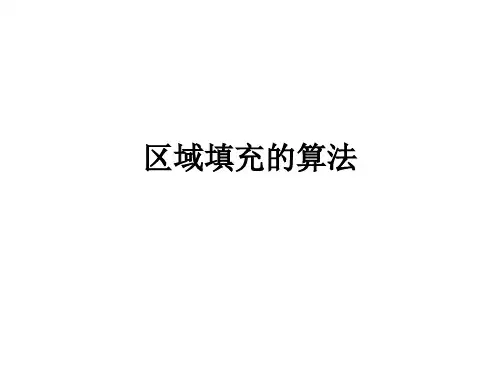
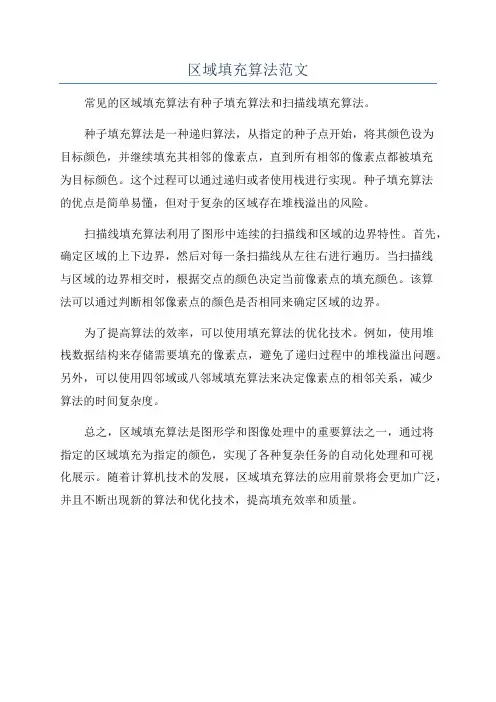
区域填充算法范文
常见的区域填充算法有种子填充算法和扫描线填充算法。
种子填充算法是一种递归算法,从指定的种子点开始,将其颜色设为
目标颜色,并继续填充其相邻的像素点,直到所有相邻的像素点都被填充
为目标颜色。
这个过程可以通过递归或者使用栈进行实现。
种子填充算法
的优点是简单易懂,但对于复杂的区域存在堆栈溢出的风险。
扫描线填充算法利用了图形中连续的扫描线和区域的边界特性。
首先,确定区域的上下边界,然后对每一条扫描线从左往右进行遍历。
当扫描线
与区域的边界相交时,根据交点的颜色决定当前像素点的填充颜色。
该算
法可以通过判断相邻像素点的颜色是否相同来确定区域的边界。
为了提高算法的效率,可以使用填充算法的优化技术。
例如,使用堆
栈数据结构来存储需要填充的像素点,避免了递归过程中的堆栈溢出问题。
另外,可以使用四邻域或八邻域填充算法来决定像素点的相邻关系,减少
算法的时间复杂度。
总之,区域填充算法是图形学和图像处理中的重要算法之一,通过将
指定的区域填充为指定的颜色,实现了各种复杂任务的自动化处理和可视
化展示。
随着计算机技术的发展,区域填充算法的应用前景将会更加广泛,并且不断出现新的算法和优化技术,提高填充效率和质量。
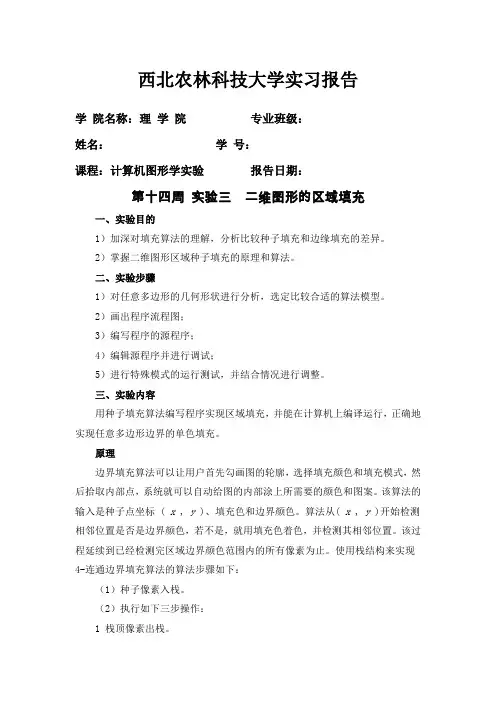
西北农林科技大学实习报告学院名称:理学院专业班级:姓名:学号:课程:计算机图形学实验报告日期:第十四周实验三二维图形的区域填充一、实验目的1)加深对填充算法的理解,分析比较种子填充和边缘填充的差异。
2)掌握二维图形区域种子填充的原理和算法。
二、实验步骤1)对任意多边形的几何形状进行分析,选定比较合适的算法模型。
2)画出程序流程图;3)编写程序的源程序;4)编辑源程序并进行调试;5)进行特殊模式的运行测试,并结合情况进行调整。
三、实验内容用种子填充算法编写程序实现区域填充,并能在计算机上编译运行,正确地实现任意多边形边界的单色填充。
原理边界填充算法可以让用户首先勾画图的轮廓,选择填充颜色和填充模式,然后拾取内部点,系统就可以自动给图的内部涂上所需要的颜色和图案。
该算法的输入是种子点坐标 ( x , y )、填充色和边界颜色。
算法从( x , y )开始检测相邻位置是否是边界颜色,若不是,就用填充色着色,并检测其相邻位置。
该过程延续到已经检测完区域边界颜色范围内的所有像素为止。
使用栈结构来实现4-连通边界填充算法的算法步骤如下:(1)种子像素入栈。
(2)执行如下三步操作:1 栈顶像素出栈。
2 将出栈像素置成填充色。
3 检查出栈像素的4-邻接点,若其中某个像素不是边界色且未置成多边形色,则把该像素入栈。
(3)检查栈是否为空,若栈非空重复执行步骤(2),若栈为空则结束。
边界填充算法可以用于填充带有内孔的平面区域。
其缺点是把太多的像素压入堆栈,有些像素甚至会入栈多次,这样一方面降低了算法的效率,另一方面还要求很大的存储空间以实现栈结构。
将之改进,可构造沿扫描线填充水平像素段的4-连通边界填充算法,其算法步骤如下:(1)种子像素入栈。
(2)执行如下三步操作:1 栈顶元素出栈。
2 填充出栈元素所在扫描行的连续像素段,从出栈的像素开始沿扫描线向左和向右填充,直到遇到边界像素为止,即每出栈一个像素,就对包含该像素的整个扫描线区间进行填充,并且记录下此时扫描线区间的x坐标范围[ x1, x2 ]。
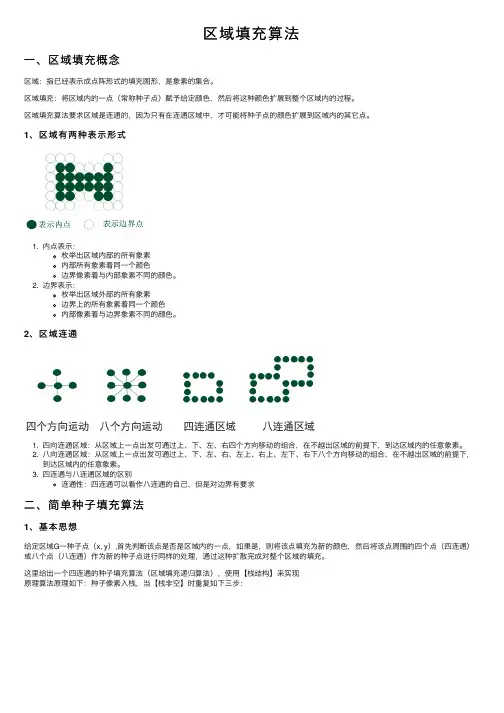
区域填充算法⼀、区域填充概念区域:指已经表⽰成点阵形式的填充图形,是象素的集合。
区域填充:将区域内的⼀点(常称种⼦点)赋予给定颜⾊,然后将这种颜⾊扩展到整个区域内的过程。
区域填充算法要求区域是连通的,因为只有在连通区域中,才可能将种⼦点的颜⾊扩展到区域内的其它点。
1、区域有两种表⽰形式1. 内点表⽰:枚举出区域内部的所有象素内部所有象素着同⼀个颜⾊边界像素着与内部象素不同的颜⾊。
2. 边界表⽰:枚举出区域外部的所有象素边界上的所有象素着同⼀个颜⾊内部像素着与边界象素不同的颜⾊。
2、区域连通1. 四向连通区域:从区域上⼀点出发可通过上、下、左、右四个⽅向移动的组合,在不越出区域的前提下,到达区域内的任意象素。
2. ⼋向连通区域:从区域上⼀点出发可通过上、下、左、右、左上、右上、左下、右下⼋个⽅向移动的组合,在不越出区域的前提下,到达区域内的任意象素。
3. 四连通与⼋连通区域的区别连通性:四连通可以看作⼋连通的⾃⼰,但是对边界有要求⼆、简单种⼦填充算法1、基本思想给定区域G⼀种⼦点(x, y),⾸先判断该点是否是区域内的⼀点,如果是,则将该点填充为新的颜⾊,然后将该点周围的四个点(四连通)或⼋个点(⼋连通)作为新的种⼦点进⾏同样的处理,通过这种扩散完成对整个区域的填充。
这⾥给出⼀个四连通的种⼦填充算法(区域填充递归算法),使⽤【栈结构】来实现原理算法原理如下:种⼦像素⼊栈,当【栈⾮空】时重复如下三步:2、算法代码这⾥给出⼋连通的种⼦填充算法的代码:void flood_fill_8(int[] pixels, int x, int y, int old_color, int new_color) { if (x < w && x > 0 && y < h && y > 0) {// 如果是旧的颜⾊⽽且还没有给他填充过if (pixels[y * w + x] == old_color) {// 填充为新的颜⾊pixels[y * w + x]== new_color);// 递归flood_fill_8(pixels, x, y + 1, old_color, new_color);flood_fill_8(pixels, x, y - 1, old_color, new_color);flood_fill_8(pixels, x - 1, y, old_color, new_color);flood_fill_8(pixels, x + 1, y, old_color, new_color);flood_fill_8(pixels, x + 1, y + 1, old_color, new_color);flood_fill_8(pixels, x + 1, y - 1, old_color, new_color);flood_fill_8(pixels, x - 1, y + 1, old_color, new_color);flood_fill_8(pixels, x - 1, y - 1, old_color, new_color);}}}3、OpenCV实现import cv2def seed_fill(img):ret, img = cv2.threshold(img, 128, 255, cv2.THRESH_BINARY_INV) label = 100stack_list = []h, w = img.shapefor i in range(1, h-1, 1):for j in range(1, w-1, 1):if (img[i][j] == 255):img[i][j] = labelstack_list.append((i, j))while len(stack_list) != 0:cur_i = stack_list[-1][0]cur_j = stack_list[-1][1]img[cur_i][cur_j] = labelstack_list.remove(stack_list[-1])# 四邻域,可改为⼋邻域if (img[cur_i-1][cur_j] == 255):stack_list.append((cur_i-1, cur_j))if (img[cur_i][cur_j-1] == 255):stack_list.append((cur_i, cur_j-1))if (img[cur_i+1][cur_j] == 255):stack_list.append((cur_i+1, cur_j))if (img[cur_i][cur_j+1] == 255):stack_list.append((cur_i, cur_j+1))cv2.imwrite('./result.jpg', img)cv2.imshow('img', img)cv2.waitKey()if __name__ == '__main__':img = cv2.imread('./test.jpeg', 0)seed_fill(img)4、简单种⼦填充算法的优点和缺点优点:1. 该算法也可以填充有孔区域缺点:1. 有些像素会多次⼊栈,降低算法效率,栈结构占空间2. 递归执⾏,算法简单,但效率不⾼,区域内每⼀像素都要进/出栈,费时费内存3. 改进算法,减少递归次数,提⾼效率三、扫描线种⼦填充算法⽬标:减少递归层次适⽤于边界表⽰的4连通区间1、基本思想在任意不间断区间中只取⼀个种⼦像素(不间断区间指在⼀条扫描线上⼀组相邻元素),填充当前扫描线上的该段区间;然后确定与这⼀区段相邻的上下两条扫描线上位于区域内的区段,并依次把它们保存起来,反复进⾏这个过程,直到所保存的各个区段都填充完毕。
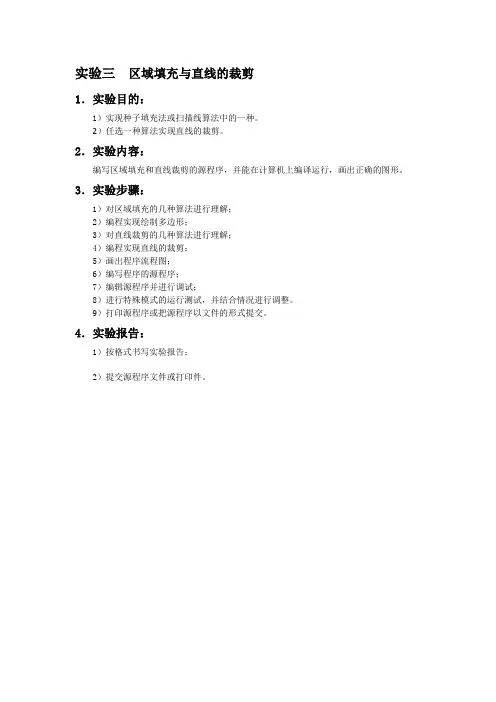
实验三区域填充与直线的裁剪1.实验目的:1)实现种子填充法或扫描线算法中的一种。
2)任选一种算法实现直线的裁剪。
2.实验内容:编写区域填充和直线裁剪的源程序,并能在计算机上编译运行,画出正确的图形。
3.实验步骤:1)对区域填充的几种算法进行理解;2)编程实现绘制多边形;3)对直线裁剪的几种算法进行理解;4)编程实现直线的裁剪;5)画出程序流程图;6)编写程序的源程序;7)编辑源程序并进行调试;8)进行特殊模式的运行测试,并结合情况进行调整。
9)打印源程序或把源程序以文件的形式提交。
4.实验报告:1)按格式书写实验报告;2)提交源程序文件或打印件。
算法描述区域填充1) 多边形由一系列首尾相连的直线段构成的图形称为多边形。
如果在多边形内任意选取不相同的两点,其连线上的所有点均在该多边形内,这样的多边形称为凸多边形;否则,称为凹多边形。
2) 种子填充算法种子填充算法又称为边界填充算法。
其基本思想是:从多边形区域的一个内点开始,由内向外用给定的颜色画点直到边界为止。
如果边界是以一种颜色指定的,则种子填充算法可逐个像素地处理直到遇到边界颜色为止。
种子填充算法常用四连通域和八连通域技术进行填充操作。
从区域内任意一点出发,通过上、下、左、右四个方向到达区域内的任意像素。
用这种方法填充的区域就称为四连通域;这种填充方法称为四向连通算法。
从区域内任意一点出发,通过上、下、左、右、左上、左下、右上和右下八个方向到达区域内的任意像素。
用这种方法填充的区域就称为八连通域;这种填充方法称为八向连通算法。
一般来说,八向连通算法可以填充四向连通区域,而四向连通算法有时不能填充八向连通区域。
例如,八向连通填充算法能够正确填充如图2.4a所示的区域的内部,而四向连通填充算法只能完成如图2.4b的部分填充。
四向连通填充算法a) 连通域及其内点b) 填充四连通域四向连通填充算法:a)种子像素压入栈中;b)如果栈为空,则转e);否则转c);c)弹出一个像素,并将该像素置成填充色;并判断该像素相邻的四连通像素是否为边界色或已经置成多边形的填充色,若不是,则将该像素压入栈;d)转b);e)结束。
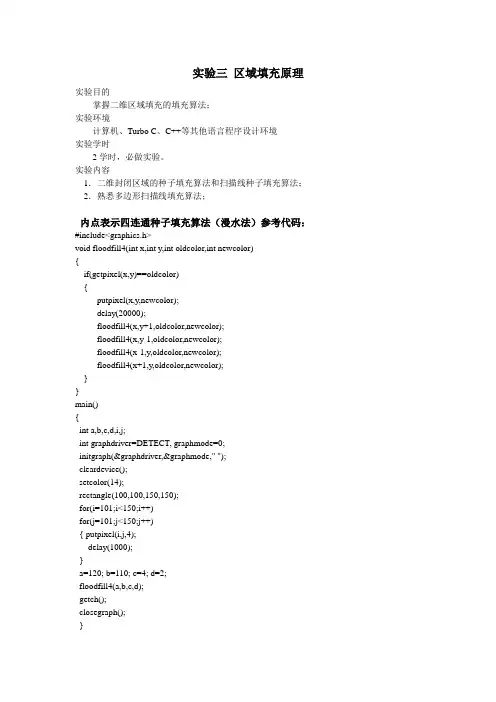
实验三区域填充原理实验目的掌握二维区域填充的填充算法;实验环境计算机、Turbo C、C++等其他语言程序设计环境实验学时2学时,必做实验。
实验内容1.二维封闭区域的种子填充算法和扫描线种子填充算法;2.熟悉多边形扫描线填充算法;内点表示四连通种子填充算法(漫水法)参考代码:#include<graphics.h>void floodfill4(int x,int y,int oldcolor,int newcolor){if(getpixel(x,y)==oldcolor){putpixel(x,y,newcolor);delay(20000);floodfill4(x,y+1,oldcolor,newcolor);floodfill4(x,y-1,oldcolor,newcolor);floodfill4(x-1,y,oldcolor,newcolor);floodfill4(x+1,y,oldcolor,newcolor);}}main(){int a,b,c,d,i,j;int graphdriver=DETECT, graphmode=0;initgraph(&graphdriver,&graphmode," ");cleardevice();setcolor(14);rectangle(100,100,150,150);for(i=101;i<150;i++)for(j=101;j<150;j++){ putpixel(i,j,4);delay(1000);}a=120; b=110; c=4; d=2;floodfill4(a,b,c,d);getch();closegraph();}边界表示的4连通区域的种子填充算法:#include<stdio.h>;#include<graphics.h>;void BoundaryFill4(int x,int y,int boundarycolor,int newcolor) {if(getpixel(x,y)!=boundarycolor&getpixel(x,y)!=newcolor) {putpixel(x,y,newcolor);delay(20000);BoundaryFill4(x,y+1,boundarycolor,newcolor);BoundaryFill4(x,y-1,boundarycolor,newcolor);BoundaryFill4(x-1,y,boundarycolor,newcolor);BoundaryFill4(x+1,y,boundarycolor,newcolor);}}main() {int a,b,c=14,d,i,j;int graphdriver=DETECT,graphmode=0;initgraph(&graphdriver,&graphmode," ");cleardevice();setcolor(c);rectangle(100,100,150,150);for(i=101;i<150;i++)for(j=101;j<150;j++) { putpixel(i,j,4); delay(1000); } a=120; b=130; d=2;BoundaryFill4(a,b,c,d);getch();closegraph();}扫描线种子填充算法参考代码:#include<graphics.h>#include<stdio.h>#include<stdlib.h>#define bordercolor 15#define backcolor 0#define seedcolor 4#define fillcolor 10typedef struct Point{int x;int y;}point;typedef struct Stack{point *base;point *top;}*stack;void initstack(stack s){(*s).base=(point*)malloc(sizeof(point));if(!(*s).base)exit(1);(*s).top=(*s).base;}void push(stack s,point p){*((*s).top)=p;(*s).top++;}int stackempty(stack s){if((*s).top==(*s).base)return(1);else return(0);}point pop(stack s){(*s).top--;return(*((*s).top));}void drawgraphics(){int a[10]={100,140,260,80,300,200,160,240,100,140}; drawpoly(5, a);/*circle(200,200,150);*/}point produceseed(){point p;p.x=200;p.y=200;return(p);}void intostack(stack s,int y0,int xl,int xr){int x,y;point tm;for(x=xl,y=y0;x<=xr&&x<getmaxx();x++){if((x!=xr&&getpixel(x,y)==backcolor&&getpixel(x+1,y)!=backcolor)||(x==xr&&getpixel(x,y)==backcolor)){tm.x=x;tm.y=y;push(s,tm);putpixel(x,y,seedcolor);}if(x==xr&&getpixel(x,y)==backcolor)break;}}void fillgraphics(){int xl=0,xr=getmaxx(),x,y;point seed;stack s=NULL;seed=produceseed();putpixel(seed.x,seed.y,seedcolor);getch();initstack(s);push(s,seed);while(!stackempty(s)){seed=pop(s);for(x=seed.x,y=seed.y;getpixel(x,y)==backcolor||getpixel(x,y)==seedcolor;x++) {putpixel(x,y,fillcolor);}xr=x-1;for(x=seed.x-1,y=seed.y;getpixel(x,y)==backcolor||getpixel(x,y)==seedcolor;x--) {putpixel(x,y,fillcolor);}xl=x+1;intostack(s,seed.y+1,xl,xr);intostack(s,seed.y-1,xl,xr);getch();}}void main(){int gdriver ,gmode ;gdriver = DETECT;initgraph(&gdriver , &gmode ,"" );drawgraphics();fillgraphics();outtextxy(180,20,"Scan line filling graphics finished!"); getch();closegraph();}多边形扫描线填充算法参考代码:/* Note:扫描线填充算法*/#include <graphics.h>#include <conio.h>#include <math.h>#define MAXPOINT 20typedef struct {int y_top;float x_int;int delta_y;float x_cps;}E_ENTRY;void putin_sl(int entry,int x1,int y1,int x2,int y2,int next_y); void sortonby(int n);void updatefl(int count,int scan);void swap(E_ENTRY *x,E_ENTRY *y);void sortonx(int entry,int first_s);void processx(int first_s,int last_s);void drawline(int scan,int x_int_c,int index);void updatesl();E_ENTRY sides[MAXPOINT];int x[MAXPOINT]={0,210,240,230,350,380,340,200,180,150}; int y[MAXPOINT]={0,410,370,200,410,340,140,180,120,300}; int s_count,first_s,last_s,scan,bottom_s,x_int_c;main(){int driver,mode;int v_count=9;driver=DETECT;initgraph(&driver,&mode,"");setcolor(3);fillarea(v_count,x,y);getch();closegraph();}fillarea(int count){sortonby(count);first_s=1;last_s=1;for(scan=sides[1].y_top;scan>bottom_s;scan--){updatefl(count,scan);processx(first_s,last_s);drawline(scan,x_int_c,first_s);updatesl();}}void putin_sl(int entry,int x1,int y1,int x2,int y2,int next_y) {int maxy;float x2_temp,xch_temp;xch_temp=(float)(x2-x1)/(float)(y2-y1);x2_temp=x2;if((y2>y1)&&(y2<next_y)){y2--;x2_temp-=xch_temp;}else{if((y2<y1)&&(y2>next_y)){y2++;x2_temp+=xch_temp;}}maxy=(y1>y2)?y1:y2;while((entry>1)&&(maxy>sides[entry-1].y_top)){sides[entry]=sides[entry-1];entry--;}sides[entry].y_top=maxy;sides[entry].delta_y=abs(y2-y1)+1;if(y1>y2)sides[entry].x_int=x1;elsesides[entry].x_int=x2_temp;sides[entry].x_cps=xch_temp;}void sortonby(int n){int k,x1,y1;s_count=0;y1=y[n];x1=x[n];bottom_s=y[n];for(k=1;k<n+1;k++){if(y1!=y[k]){s_count++;putin_sl(s_count,x1,y1,x[k],y[k],y[k+1]);}else{/* line((short)x1,480-(short)y1,(short)x[k],480-(short)y1);*/moveto((short)x1,480-(short)y1);lineto((short)x[k],480-(short)y1);}if(y[k]<bottom_s) bottom_s=y[k];y1=y[k];x1=x[k];}}void updatefl(int count,int scan){while((sides[last_s+1].y_top>scan)&&(last_s<count))last_s++;while(sides[first_s].delta_y==0) first_s++;}void swap(E_ENTRY *x,E_ENTRY *y){int i_temp;float f_temp;i_temp=x->y_top;x->y_top=y->y_top;y->y_top=i_temp;f_temp=x->x_int;x->x_int=y->x_int;y->x_int=f_temp;i_temp=x->delta_y;x->delta_y=y->delta_y;y->delta_y=i_temp;f_temp=x->x_cps;x->x_cps=y->x_cps;y->x_cps=f_temp;}void sortonx(int entry,int first_s){while((entry>first_s)&&(sides[entry].x_int<sides[entry-1].x_int)) {swap(&sides[entry],&sides[entry-1]);entry--;}}void processx(int first_s,int last_s){int k;x_int_c=0;for(k=first_s;k<last_s+1;k++){if(sides[k].delta_y>0){x_int_c++;sortonx(k,first_s);}}}void drawline(int scan,int x_int_c,int index){int k,x,x1,x2;for(k=1;k<(int)(x_int_c/2+1.5);k++){while(sides[index].delta_y==0)index++;x1=(int)(sides[index].x_int+0.5);index++;while(sides[index].delta_y==0)index++;x2=(int)(sides[index].x_int+0.5);/*line((short)x1,480-(short)scan,(short)x2,480-(short)scan);*/ moveto((short)x1,480-(short)scan);lineto((short)x2,480-(short)scan);index++;}}void updatesl(){int k;for(k=first_s;k<last_s+1;k++){if(sides[k].delta_y>0){sides[k].delta_y--;sides[k].x_int-=sides[k].x_cps;}}}。
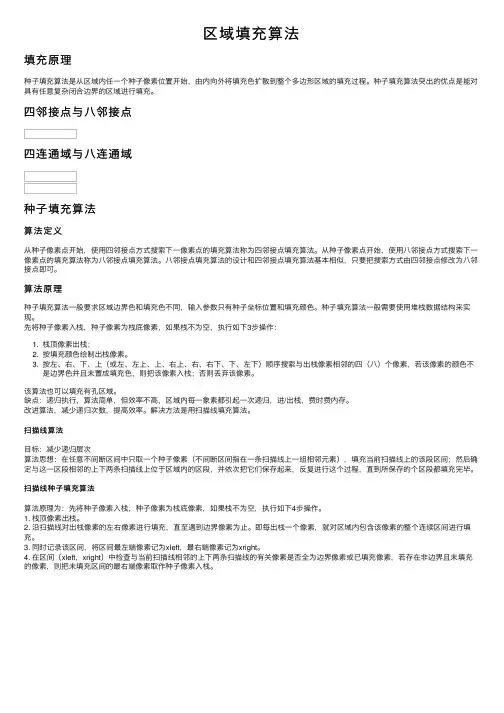
区域填充算法填充原理种⼦填充算法是从区域内任⼀个种⼦像素位置开始,由内向外将填充⾊扩散到整个多边形区域的填充过程。
种⼦填充算法突出的优点是能对具有任意复杂闭合边界的区域进⾏填充。
四邻接点与⼋邻接点四连通域与⼋连通域种⼦填充算法算法定义从种⼦像素点开始,使⽤四邻接点⽅式搜索下⼀像素点的填充算法称为四邻接点填充算法。
从种⼦像素点开始,使⽤⼋邻接点⽅式搜索下⼀像素点的填充算法称为⼋邻接点填充算法。
⼋邻接点填充算法的设计和四邻接点填充算法基本相似,只要把搜索⽅式由四邻接点修改为⼋邻接点即可。
算法原理种⼦填充算法⼀般要求区域边界⾊和填充⾊不同,输⼊参数只有种⼦坐标位置和填充颜⾊。
种⼦填充算法⼀般需要使⽤堆栈数据结构来实现。
先将种⼦像素⼊栈,种⼦像素为栈底像素,如果栈不为空,执⾏如下3步操作:1. 栈顶像素出栈;2. 按填充颜⾊绘制出栈像素。
3. 按左、右、下、上(或左、左上、上、右上、右、右下、下、左下)顺序搜索与出栈像素相邻的四(⼋)个像素,若该像素的颜⾊不是边界⾊并且未置成填充⾊,则把该像素⼊栈;否则丢弃该像素。
该算法也可以填充有孔区域。
缺点:递归执⾏,算法简单,但效率不⾼,区域内每⼀象素都引起⼀次递归,进/出栈,费时费内存。
改进算法,减少递归次数,提⾼效率。
解决⽅法是⽤扫描线填充算法。
扫描线算法⽬标:减少递归层次算法思想:在任意不间断区间中只取⼀个种⼦像素(不间断区间指在⼀条扫描线上⼀组相邻元素),填充当前扫描线上的该段区间;然后确定与这⼀区段相邻的上下两条扫描线上位于区域内的区段,并依次把它们保存起来,反复进⾏这个过程,直到所保存的个区段都填充完毕。
扫描线种⼦填充算法算法原理为:先将种⼦像素⼊栈,种⼦像素为栈底像素,如果栈不为空,执⾏如下4步操作。
1. 栈顶像素出栈。
2. 沿扫描线对出栈像素的左右像素进⾏填充,直⾄遇到边界像素为⽌。
即每出栈⼀个像素,就对区域内包含该像素的整个连续区间进⾏填充。
3. 同时记录该区间,将区间最左端像素记为xleft,最右端像素记为xright。
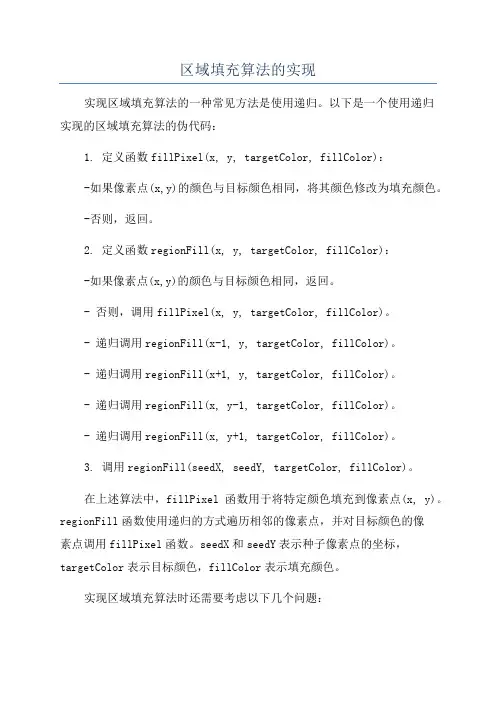
区域填充算法的实现实现区域填充算法的一种常见方法是使用递归。
以下是一个使用递归实现的区域填充算法的伪代码:1. 定义函数fillPixel(x, y, targetColor, fillColor):-如果像素点(x,y)的颜色与目标颜色相同,将其颜色修改为填充颜色。
-否则,返回。
2. 定义函数regionFill(x, y, targetColor, fillColor):-如果像素点(x,y)的颜色与目标颜色相同,返回。
- 否则,调用fillPixel(x, y, targetColor, fillColor)。
- 递归调用regionFill(x-1, y, targetColor, fillColor)。
- 递归调用regionFill(x+1, y, targetColor, fillColor)。
- 递归调用regionFill(x, y-1, targetColor, fillColor)。
- 递归调用regionFill(x, y+1, targetColor, fillColor)。
3. 调用regionFill(seedX, seedY, targetColor, fillColor)。
在上述算法中,fillPixel函数用于将特定颜色填充到像素点(x, y)。
regionFill函数使用递归的方式遍历相邻的像素点,并对目标颜色的像素点调用fillPixel函数。
seedX和seedY表示种子像素点的坐标,targetColor表示目标颜色,fillColor表示填充颜色。
实现区域填充算法时还需要考虑以下几个问题:1.像素点的表示:图像可以由二维数组表示,其中每个元素表示一个像素点的颜色。
2.填充颜色选择:填充颜色可以由RGB值表示,或者在预定义的颜色集合中选择。
3.边界处理:对于位于图像边界上的种子像素点,需要特殊处理以防止数组越界错误。
4.递归终止条件:填充算法使用递归,需要定义递归终止的条件,以防止无限递归。
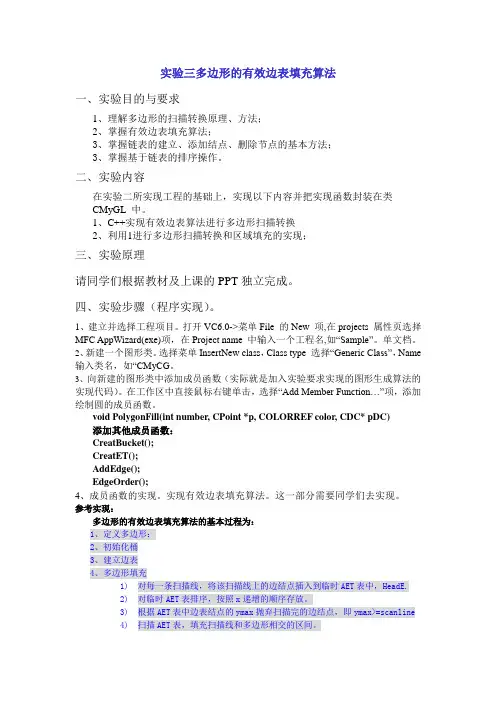
实验三多边形的有效边表填充算法一、实验目的与要求1、理解多边形的扫描转换原理、方法;2、掌握有效边表填充算法;3、掌握链表的建立、添加结点、删除节点的基本方法;3、掌握基于链表的排序操作。
二、实验内容在实验二所实现工程的基础上,实现以下内容并把实现函数封装在类CMyGL 中。
1、C++实现有效边表算法进行多边形扫描转换2、利用1进行多边形扫描转换和区域填充的实现;三、实验原理请同学们根据教材及上课的PPT独立完成。
四、实验步骤(程序实现)。
1、建立并选择工程项目。
打开VC6.0->菜单File 的New 项,在projects 属性页选择MFC AppWizard(exe)项,在Project name 中输入一个工程名,如“Sample”。
单文档。
2、新建一个图形类。
选择菜单InsertNew class,Class type 选择“Generic Class”,Name 输入类名,如“CMyCG。
3、向新建的图形类中添加成员函数(实际就是加入实验要求实现的图形生成算法的实现代码)。
在工作区中直接鼠标右键单击,选择“Add Member Function…”项,添加绘制圆的成员函数。
void PolygonFill(int number, CPoint *p, COLORREF color, CDC* pDC)添加其他成员函数:CreatBucket();CreatET();AddEdge();EdgeOrder();4、成员函数的实现。
实现有效边表填充算法。
这一部分需要同学们去实现。
参考实现:多边形的有效边表填充算法的基本过程为:1、定义多边形:2、初始化桶3、建立边表4、多边形填充1)对每一条扫描线,将该扫描线上的边结点插入到临时AET表中,HeadE.2)对临时AET表排序,按照x递增的顺序存放。
3)根据AET表中边表结点的ymax抛弃扫描完的边结点,即ymax>=scanline4)扫描AET表,填充扫描线和多边形相交的区间。
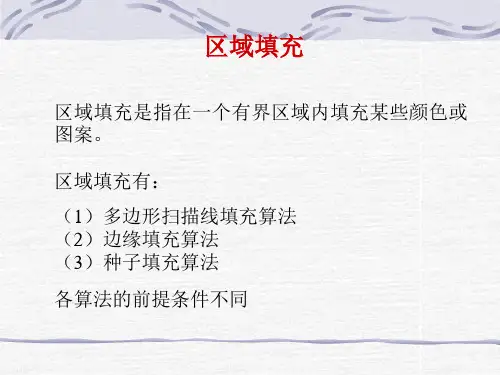
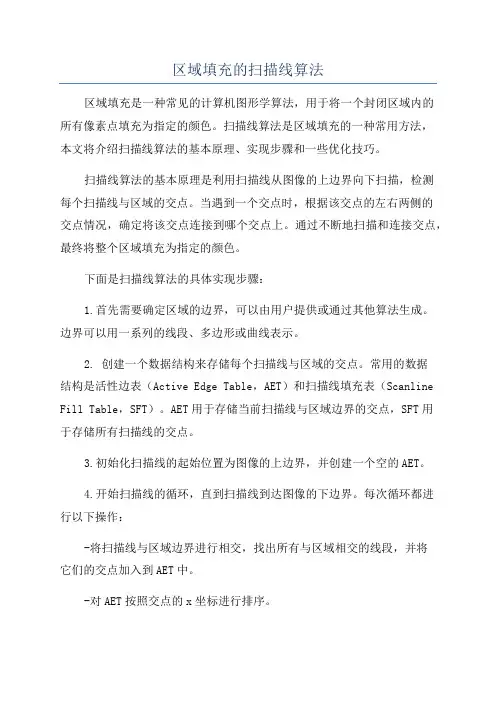
区域填充的扫描线算法区域填充是一种常见的计算机图形学算法,用于将一个封闭区域内的所有像素点填充为指定的颜色。
扫描线算法是区域填充的一种常用方法,本文将介绍扫描线算法的基本原理、实现步骤和一些优化技巧。
扫描线算法的基本原理是利用扫描线从图像的上边界向下扫描,检测每个扫描线与区域的交点。
当遇到一个交点时,根据该交点的左右两侧的交点情况,确定将该交点连接到哪个交点上。
通过不断地扫描和连接交点,最终将整个区域填充为指定的颜色。
下面是扫描线算法的具体实现步骤:1.首先需要确定区域的边界,可以由用户提供或通过其他算法生成。
边界可以用一系列的线段、多边形或曲线表示。
2. 创建一个数据结构来存储每个扫描线与区域的交点。
常用的数据结构是活性边表(Active Edge Table,AET)和扫描线填充表(Scanline Fill Table,SFT)。
AET用于存储当前扫描线与区域边界的交点,SFT用于存储所有扫描线的交点。
3.初始化扫描线的起始位置为图像的上边界,并创建一个空的AET。
4.开始扫描线的循环,直到扫描线到达图像的下边界。
每次循环都进行以下操作:-将扫描线与区域边界进行相交,找出所有与区域相交的线段,并将它们的交点加入到AET中。
-对AET按照交点的x坐标进行排序。
-从AET中取出相邻的两个交点,根据这两个交点之间的像素点是否在区域内来决定是否填充这些像素点。
5.当扫描线到达图像的下边界时,完成填充。
扫描线算法的实现可能会遇到一些边界情况和优化需求。
下面是一些常见的优化技巧:1.边界处理:在AET中存储的交点需要进行边界处理,确保交点处于图像范围内。
2.垂直线段处理:对于垂直线段,可以进行特殊处理,避免在AET中重复存储相同的交点。
3.区域内部边界处理:当区域内部有不连续的边界时,需要对交点进行合并,避免出现多余的像素点填充。
4.使用扫描线填充算法优化:对于大尺寸的区域填充,可以使用扫描线填充算法进行优化。
计算机图形学——区域填充的扫描线算法一.实验名称:区域填充的扫描线算法二.实验目的:1、理解区域填充扫描线算法的原理;2、实现区域填充的扫描线算法并测试;三.算法原理:算法基本思想: 首先填充种子点所在扫描线上位于区域内的区段,然后确定与该区段相邻的上下两条扫描线上位于区域内的区段,并依次将各区段的起始位置保存, 这些区段分别被用区域边界色显示的像素点所包围。
随后,逐步取出一开始点并重复上述过程,直到所保存各区段都填充完毕为止。
借助于栈结构,区域填充的扫描线算法之步骤如下:Step 1. 初始化种子点栈:置种子点栈为空栈,并将给定的种子点入栈;Step 2. 出栈:若种子点栈为空,算法结束;否则,取栈顶元素(x,y)为种子点;Step 3. 区段填充:从种子点(x, y) 开始沿纵坐标为y 的当前扫描线向左右两个方向逐像素点进行填色,其颜色值置为newcolor 直至到达区域边界。
分别以xl 和xr 表示该填充区段两端点的横坐标;Step 4. 新种子点入栈: 分别确定当前扫描线上、下相邻的两条扫描线上位于区段[xl, xr] 内的区域内的区段。
若这些区段内的像素点颜色值为newolor ,则转至Step 2;否则以区段的右端点为种子点入种子点栈,再转至Step 2。
四.原程序代码:/*****************************************//*4-ScanLineFill 区域填充的扫描线算法实现*//*****************************************/#include <stdio.h>#include <conio.h>#include <graphics.h>#include <malloc.h>#define Stack_Size 100 //栈的大小常量//定义结构体,记录种子点typedef struct{int x;int y;}Seed;//定义顺序栈(种子点)typedef struct{Seed Point[Stack_Size];int top;}SeqStack;//初始化栈操作void InitStack(SeqStack *&S){S=(SeqStack *)malloc(sizeof(SeqStack));S->top=-1;}//种子点栈置空;void setstackempty (SeqStack *S){S->top==-1;}//种子点栈状态检测函数int isstackempty (SeqStack *S){if(S->top==-1)return true; //空栈返回trueelsereturn false; //非空栈返回false}//种子点入栈;int stackpush (SeqStack *&S,Seed point){if(S->top==Stack_Size-1)//栈已满,返回false return false;S->top++;//栈未满,栈顶元素加1S->Point[S->top]= point;return true;}//取栈顶元素;int stackpop (SeqStack *&S,Seed &point){if(S->top==-1)//栈为空,返回falsereturn false;point=S->Point[S->top];S->top --;//栈未空,top减1return true;}//画圆void CirclePoints (int xc, int yc, int x, int y, int Color) {putpixel (xc + x, yc + y, Color);putpixel (xc + x, yc - y, Color);putpixel (xc - x, yc + y, Color);putpixel (xc - x, yc - y, Color);putpixel (xc + y, yc + x, Color);putpixel (xc + y, yc - x, Color);putpixel (xc - y, yc + x, Color);putpixel (xc - y, yc - x, Color); }//中点画圆算法void MidpointCircle(int radius, int Color) {int x, y;float d;x=0;y=radius;d=5.0/4-radius;CirclePoints(250,250,x,y,Color);while(x<y){if (d<0){d+=x*2.0+3;}else{d+=(x-y)*2.0+5;y--;}x++;CirclePoints(250,250,x,y,Color);}}//四连通扫描线算法void ScanLineFill4(int x, int y, int oldcolor, int newcolor) {int xl, xr, i;bool SpanNeedFill;Seed pt;//种子点SeqStack *S;//定义顺序栈InitStack(S);//定义了栈之后必须把栈先初始化setstackempty(S);//种子点栈置空;pt.x = x;pt.y = y;stackpush (S,pt); // 种子点(x, y)入栈while (!isstackempty(S)){stackpop (S,pt);//取种子点y = pt.y;x = pt.x;while (getpixel (x,y)==oldcolor) {// 从种子点开始向右填充putpixel (x, y, newcolor);x++;}xr = x -1;x = pt.x -1;while (getpixel (x,y)==oldcolor) { // 从种子点开始向左填充putpixel (x, y, newcolor);x--;}xl = x + 1;x = xl;y = y +1; // 处理上面一条扫描线while (x < xr){SpanNeedFill = false;while (getpixel (x, y)==oldcolor){SpanNeedFill = true;x++ ;} // 待填充区段搜索完毕if (SpanNeedFill){// 将右端点作为种子点入栈pt.x = x - 1;pt.y = y;stackpush (S,pt);SpanNeedFill = false;} //继续向右检查以防遗漏while ((getpixel (x, y)!=oldcolor) && (x< xr)) x++;} //上一条扫描线上检查完毕x = xl;y=y-2; // 处理下面一条扫描线while (x < xr){SpanNeedFill = false;while (getpixel (x, y)==oldcolor){SpanNeedFill=true;x++ ;}if (SpanNeedFill){pt.x= x - 1;pt.y = y;stackpush (S,pt);SpanNeedFill=false;}while ((getpixel (x, y)!=oldcolor) && (x < xr))x++;}}}//主函数检测void main(){int radius,color;int x,y;//种子点int oldcolor,newcolor;//原色与填充色//输入参数值printf("input radius and color:\n");//画圆参数scanf("%d,%d",&radius,&color);printf("input x and y:\n"); //读入内点scanf("%d,%d", &x, &y);printf("input oldcolor and newcolor:\n"); //读入原色与填充色scanf("%d,%d", &oldcolor, &newcolor);int gdriver = DETECT,gmode;initgraph(&gdriver, &gmode, "c:\\tc");// 用背景色清空屏幕cleardevice();// 设置绘图色为红色setcolor(RED);MidpointCircle(radius,color);//用中点画圆算法画圆rectangle(150, 150, 350, 350);//再画一个矩形区域ScanLineFill4 (x,y,oldcolor,newcolor);//扫描线区域填充getch();closegraph();}五.运行结果与讨论:测试结果1:测试结果2:六.实验分析与讨论:1.通过借助栈这一数据结构,完成了区域填充的扫描线算法的实现,并利用以前所学的画圆等算法,进行综合运用,在此基础上进行扩充,设计多种图案,进行扫描线填充算法的检测,都得到了理想的结果,体现了算法的有效性;2.栈的数据结构给种子点的操作带来了极大的方便,为算法的实现提供了便利,同时还提高了算法的复用性和可靠性;3.此扫描线填充算法能够对多种图案进行填充,展现了算法的实用性。
贵州大学计算机图形学实验报告学院:计算机科学与信息学院专业:软件工程班级:反映)根据扫描线的连贯性可知:一条扫描线与多边形的交点中,入点和出点之间所有点都是多边形的内部点。
所以,对所有的扫描线填充入点到出点之间的点就可填充多边形。
如何具体实现(如何找到入点、出点)?根据区域的连贯性,分为3个步骤:(1)求出扫描线与多边形所有边的交点;(2)把这些交点按x坐标值以升序排列;(3)对排序后的交点进行奇偶配对,对每一对交点间的区域进行填充。
步骤(3)如上图:对y=8的扫描线,对交点序列按x坐标升序排序得到的交点序列是(2,4,9,13),然后对交点2与4之间、9与13之间的所有象素点进行填充。
求交点、排序、配对、填色利用链表:与当前扫描线相交的边称为活性边(Active Edge),把它们按与扫描线交点x坐标递增的顺序存入一个链表中,称为活性边表AEL (AEL, Active Edge List)。
它记录了多边形边沿扫描线的交点序列。
AEL中每个对象需要存放的信息:ymax:边所交的最高扫描线;x:当前扫描线与边的交点;Δx:从当前扫描线到下一条扫描线之间的x增量next:指向下一对象的指针。
伪码:建立ET,置y为ET中非空桶的最小序号;置AEL表为空,且把y桶中ET表的边加入AEL表中;while AEL表中非空do begin对AEL表中的x、Δx按升序排列;按照AEL表中交点前后次序,在每对奇偶交点间的x段予以填充;计算下一条扫描线:y=y+1;if 扫描线y=ymax then 从AEL表中删除这些边;对在AEL表中的其他边,计算与下一条扫描线的交点:x=x +Δx 按照扫描线y值把ET表中相应桶中的边加入AEL表中;endend of algorithm二、区域填充算法:区域可采用两种表示形式:内点表示枚举区域内部的所有像素;内部的所有像素着同一个颜色;边界像素着不同的颜色。
边界表示:枚举出边界上所有的像素;边界上的所有像素着同一颜色;内部像素着不同的颜色。
西安工程大学实验报告课程实验名称区第 1 页共 6 页系别组别_____________ 实验报告日期年月日姓名学号报告退发 ( 订正、重做 )E_mail:_________________________________ 教师审批评分___________________区域填充算法一、实验目的和任务1. 学习多边形填充的基于扫描线的区域填充算法2. 编程实现区域填充算法二、实验环境和设备windows系统下 vs2012 c++三、实验步骤和过程在MFC框架中通过菜单与对话框实现多边形顶点参量的输入,选择各种填充算法中的两种进行展示,其中栅栏填充和边填充算法不能同时选择,多边形的表示根据所选择的算法,以内点表示或边界表示均可四、实验故障与排除五、总结附录#include <glut.h>#include<Windows.h>const int POINTNUM = 7; //多边形点数./******定义结构体用于活性边表AET和新边表NET***********************************/ typedef struct XET{float x;float dx, ymax;XET* next;}AET, NET;/******定义点结构体point******************************************************/struct point{float x;float y;}polypoint[POINTNUM] = { 250, 50, 550, 150, 550, 400, 250, 250, 100, 350, 100, 100, 120, 30 };//多边形顶点void PolyScan(){/******计算最高点的y坐标(扫描到此结束)****************************************/int MaxY = 0;int i;for (i = 0; i<POINTNUM; i++)if (polypoint[i].y>MaxY)MaxY = polypoint[i].y;/*******初始化AET表***********************************************************/ AET *pAET = new AET;pAET->next = NULL;/******初始化NET表************************************************************/ NET *pNET[1024];for (i = 0; i <= MaxY; i++){pNET[i] = new NET;pNET[i]->next = NULL;}glClear(GL_COLOR_BUFFER_BIT); //赋值的窗体显示.glColor3f(0.0, 0.0, 0.0); //设置直线的颜色红色glBegin(GL_POINTS);/******扫描并建立NET表*********************************************************/ for (i = 0; i <= MaxY; i++){for (int j = 0; j<POINTNUM; j++)if (polypoint[j].y == i){ //一个点跟前面的一个点形成一条线段。
填充算法实验报告实验报告:填充算法研究与实验1. 实验目的填充算法在计算机图形学中有着广泛的应用,并且对于计算机图形学的发展有着重要意义。
本次实验旨在通过对填充算法的研究与实验,了解填充算法的原理和应用,掌握填充算法的基本实现方法,实现简单的填充效果。
2. 实验背景填充算法是计算机图形学中的一种常用算法,用于将指定区域进行填充。
填充算法可以应用于图像的编辑、区域选择、图像渲染等方面。
常见的填充算法包括区域种子填充算法、扫描线填充算法等。
3. 实验内容本次实验主要研究和实现了区域种子填充算法和扫描线填充算法。
区域种子填充算法是指通过指定一个待填充的种子点,在其周围的区域进行填充。
扫描线填充算法是指通过扫描图像的每一行,在特定条件下对像素进行填充。
在实验中,我们首先实现了区域种子填充算法。
通过在待填充的区域中选择一个点作为种子点,然后从指定点出发,通过递归或栈的方式对相邻的像素进行着色,直到遇到与起始点像素颜色不同的像素为止,从而完成填充效果。
其次,我们实现了扫描线填充算法。
这种算法的核心是扫描图像的每一行,在每一行上找到待填充区域的边界并将其记录下来,然后根据边界的位置对每一个像素进行填充。
我们采用了活性边表和扫描线转换算法来实现扫描线填充算法。
4. 实验结果通过实验我们成功实现了区域种子填充算法和扫描线填充算法,在输入指定的区域和种子点后,程序能够快速地对指定区域进行填充,生成了良好的填充效果。
5. 实验分析区域种子填充算法是一种简单且直观的填充算法,但对于复杂区域的填充效果并不理想。
它的主要缺点是可能导致栈溢出或填充效果不均匀,因此在实际应用中不太常用。
相比之下,扫描线填充算法具有更好的填充效果和效率。
其使用了活性边表和扫描线转换算法,可以在进行每一行的扫描时快速地找到边界并进行填充。
但该算法无法很好地处理较复杂的几何形状,例如存在凹陷和自相交的区域。
6. 实验总结通过本次实验,我们深入学习了填充算法的基本原理和实现方法,并成功实现了区域种子填充算法和扫描线填充算法。
区域填充种子算法实现实验三区域填充种子算法实现实验目的:1、熟练在Visual C++中程序实现及调试的能力。
2、通过程序的设计熟练区域填充种子算法过程;3、掌握堆栈在数据结构中的应用实验内容:1、visual c++中菜单的修改,点的输入及鼠标函数的控制;2、复习数据结构中堆栈的建立,入栈,出栈等函数;3、实现整个多边形的区域填充种子算法,与扫描转换算法进行区分;实验步骤:预处理:多边形点列的输入,存储于数组中P[100],种子点的输入,确定为point(x,y)确定多边形的边界色(旧画笔色),初始色(背景色),填充色(新画笔色);数据结构的建立:建立堆栈,包括数组stack[100],及一个指标top,用来指向当前堆栈的最外面的栈口的元素。
步骤:1、堆栈置为空,top=0;2、将初始的种子点point进栈,push(x,y);3、填色堆栈非空即top>0时,一直循环下列步骤取栈顶的元素,出栈pop(x,y),savex=x;从当前点开始沿当前扫描线往右检验,若有未填新色的,则填色。
然后同样往左检验。
当前扫描线俩个方向都检查完后,检验上一条扫描线y=y+1; 若有未填新色的,则把所有未填新色区间的右端点压入堆栈。
同理检验下一条扫描线y=y-2;实验指导:一、在实验二的基础上进行编程;(1)引入实验二代码scanline.dsw二、编辑菜单资源选中窗口左边栏的“ResourceView ”,其中的“Menu ”,双击“IDR_MAINFRAME ”,右边即为菜单,在菜单上空处双击,出项如图所示窗口,其中弹出不选中;如上,同样创建其余菜单项。
(如下表);三、添加消息处理函数由菜单的“查看”,“建立类向导”,打开ClassWizard (也可CTRL+W )为应用程序添加与菜单项相关的消息处理函数,ClassName 栏选中CScanLineView 类,根据表建立。
输入菜单项名称,(如显示多边形)双击,出现如下窗口四、程序结构代码 1、添加全局变量在CScanLineView.h 文件中相应位置添加如下代码:(红体为需加入代码)// Implementation public:CPoint P[100], pt, stack[100]; int top, flag , num ;说明: pt 定义为全局变量,为种子点坐标; stack[100]为堆栈;top 为堆栈的最外的元素的位子; flag 为指标,判别flag=1时鼠标左键按下可取种子点。
实验三区域填充算法的实现
一、实验目的和要求:
1、掌握区域填充算法基本知识
2、理解区域的表示和类型,能正确区分四连通和八连通的区域
3、了解区域填充的实现原理,利用Microsoft Visual C++ 6.0或win-TC实现区
域种子填充的递归算法。
二、实验内容:
1、编程完成区域填色
2、利用画线函数,在屏幕上定义一个封闭区域。
3、利用以下两种种子填充算法,填充上述步骤中定义的区域
(1)边界表示的四连通区域种子填充的实现
(2)内点表示的四连通区域种子填充的实现
4、将上述算法作部分改动应用于八连通区域,构成八连通区域种子填充算法,
并编程实现。
三、实验结果分析
四连通图的实现:
程序代码:
#include<graphics.h>
#include <conio.h>
#include<math.h>
#include<time.h>
void BoundaryFill4(int x,int y,int Boundarycolor,int newcolor)
{
if(getpixel(x,y) != newcolor && getpixel(x,y) !=Boundarycolor)
{
putpixel(x,y,newcolor);
Sleep(1);
BoundaryFill4(x-1,y,Boundarycolor,newcolor);
BoundaryFill4(x,y+1,Boundarycolor,newcolor);
BoundaryFill4(x+1,y,Boundarycolor,newcolor);
BoundaryFill4(x,y-1,Boundarycolor,newcolor);
}
}
void polygon(int x0,int y0,int a,int n,float af)
{
int x,y,i;
double dtheta,theta;
if(n<3)
return;
dtheta=6.28318/n;
theta=af*0.0174533;
moveto(x0,y0);x=x0;y=y0;
for(i=1;i<n;i++)
{
x=x+a*cos(theta);y=y+a*sin(theta);
lineto(x,y);theta=theta+dtheta;
}
lineto(x0,y0);
}
void main()
{
int x=50,y=75;
int a,b,c,d,i,j;
int graphdriver=DETECT;
int graphmode=0;
initgraph(&graphdriver,&graphmode," ");
cleardevice();
setcolor(RGB(0,255,0));
setfillstyle(WHITE);
polygon(x,y,60,5,0.);
a=100;
b=100;
c=RGB(0,255,0);
d=RGB(255,0,255);
BoundaryFill4(a,b,c,d);
getch();
closegraph();}
实验结果
八连通的实现
程序代码:
#include<graphics.h>
#include<conio.h>
#include<time.h>
#include <malloc.h>
#include <windows.h>
#define MaxSize 100
typedef struct{
int x;
int y;
}Seed,ElemType;
typedef struct
{
ElemType data[MaxSize];
int top; //栈顶指针
} SqStack;
void InitStack(SqStack *&s)
{
s=(SqStack *)malloc(sizeof(SqStack));
s->top=-1;
}
int StackEmpty(SqStack *s)
{
return(s->top==-1);
}
int Push(SqStack *&s,ElemType e)
{
if (s->top==MaxSize-1)
return 0;
s->top++;
s->data[s->top]=e;
return 1;
}
int Pop(SqStack *&s,ElemType &e)
{
if (s->top==-1)
return 0;
e=s->data[s->top];
s->top--;
return 1;
}
void floodfill8(int x,int y,int oldcolor,int newcolor) {
if(getpixel(x,y)==oldcolor)
{
putpixel(x,y,newcolor);
Sleep(2);
floodfill8(x,y+1,oldcolor,newcolor);
floodfill8(x,y-1,oldcolor,newcolor);
floodfill8(x-1,y,oldcolor,newcolor);
floodfill8(x+1,y,oldcolor,newcolor);
floodfill8(x+1,y+1,oldcolor,newcolor);
floodfill8(x+1,y-1,oldcolor,newcolor);
floodfill8(x-1,y+1,oldcolor,newcolor);
floodfill8(x-1,y-1,oldcolor,newcolor);
}
}
void main()
{
int a,b,c,d,i,j;
int graphdriver=DETECT;
int graphmode=0;
initgraph(&graphdriver,&graphmode," "); cleardevice();
setfillstyle(RGB(255,255,255));
setcolor(GREEN);
int points[]={320,200,270,290,370,290}; fillpoly(3,points);
rectangle(500,420,100,100);
a=RGB(255,255,255);
b=RGB(255,0,0);
floodfill8(320,240,a,b);
c=RGB(0,0,0);
d=RGB(0,0,255);
floodfill8(320,180,c,d);
getch();
closegraph();
}
实验结果:
2、结果分析:
通过以上各算法运行结果分析与对比可知:
1.四连通算法的缺点是有时不能通过狭窄区域,因而不能填满多边形。
2.八连通算法的缺点是有时会填出多边形的边界。
3.由于填不满往往比涂出更易于补救,因此四连通算法比八连通算法用的更多。